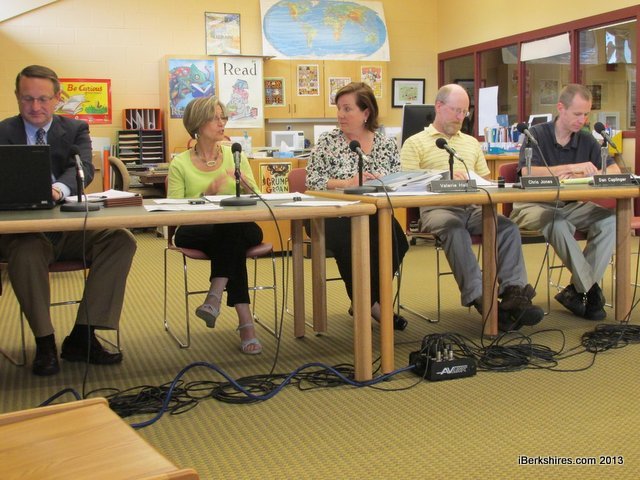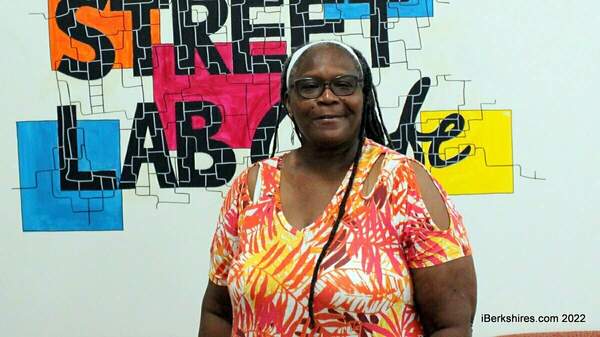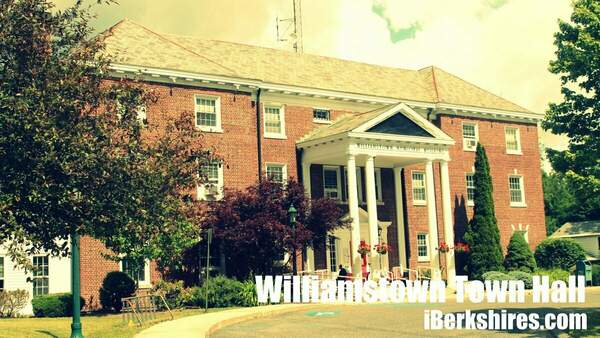
Williamstown School Board Sets Calendar, Debates Regionalization
 Williamstown Elementary School Principal Joelle Brookner meets with the School Committee on Wednesday. Williamstown Elementary School Principal Joelle Brookner meets with the School Committee on Wednesday. |
WILLIAMSTOWN, Mass. — The Williamstown School Committee on Wednesday voted to align next year's calendar with the local high school's schedule and debated whether the PK-6 school should take its relationship with that high school to the next level.
The panel unanimously approved a 2013-14 school year that sees children in Grades 1-6 returning to WES after Labor Day, on Wednesday, Sept. 4, and sees the school year ending (barring snow days) on Thursday, June 19.
The decision came as a relief to WES Principal Joelle Brookner, who said she is happy to have an answer for those families who have been clamoring for some certainty.
"Many, many phone calls and many, many emails," Brookner told the committee. "I appreciate the patience of our parents. We would have liked to have had a calendar before now."
Next year's schedule is a departure from years past, when the school has started the week before Labor Day then taken a three-day weekend.
Tri-District Superintendent Rose Ellis explained the delay in nailing down the dates was because of negotiations with the teachers' unions at the tri-district's three schools: Williamstown, Mount Greylock Regional High School and Lanesborough Elementary School.
"I think it's just a byproduct of the fact that there are different timings going on, and it's hard to nail things down," Ellis said. "We had the support of our (teachers) associations. That's not the issue.
"There are a number of moving parts."
Ellis said Wednesday that she would ask the Lanesborough School Committee to consider a similar alignment with the Mount Greylock schedule. Both towns' elementary schools send the overwhelming majority of their students to the junior-senior high school on Cold Spring Road.
The advantages of having all three schools on the same schedule are twofold: convenience for families with children in two different schools and the ability to hold tri-district wide professional development days. One such "PD" day is scheduled for Friday, Sept. 20, Ellis said.
As for waiting until after Labor Day to start classes, that could be a one-time event.
"I think we're committed long-term to starting before Labor Day," newly elevated Chairwoman Valerie Hall said.
"I think you're right," Ellis replied. "This might be an aberration this year."
The longer-term question before the committee on Wednesday involved the work of the Regional District Agreement Committee, which is studying whether to expand the Grade 7-12 Mount Greylock Regional School District to include both of Mount Greylock's main "feeder" schools.
School Committee member Dan Caplinger, who represents the panel on the RDAC along with former WES Chairwoman Margaret McComish, brought his colleagues up to speed on the regionalization study and previewed an eventful week next week.
The RDAC will host two information sessions for residents of the tri-district: Tuesday, June 18, at 5:30 at Mount Greylock and Wednesday, June 19, at 7 p.m. at LES.
Based in part on the feedback from those sessions — and a host of community outreach sessions it has held since the RDAC convened in February — the Mount Greylock Regional School Committee will decide whether to formally ask Lanesborough and Williamstown to join the district.
Ellis, who serves as superintendent for all three schools, noted that while regionalization would be a major step, it would not be a radical change for the schools.
"We are actually working on Phase 2 of regionalization," Ellis said. "We've already done Phase 1. We're already reducing our costs and and sharing costs. We've probably saved $300,000 to $400,000 by reducing the number of superintendents and administrative staff."
Caplinger said "Phase 2" would bring more savings as well as educational advantages.
From a financial standpoint, a fully integrated district would be eligible for state aid for transportation and a higher rate of reimbursement if and when Mount Greylock enters the Massachusetts School Building Authority's construction program.
"One of the most important [benefits] is the coordination of curriculum that would result," Caplinger said. "We've been fortunate to do some of that already, but as some of the faculty members on the committee have pointed out, a lot of that happens because of the goodwill of all involved. Regionalization formalizes the collaborations we've been able to put in place and expands collaboration."
Caplinger and Ellis fielded some questions about whether regionalization makes sense for WES.
"I'm hard-pressed to realize what the real benefit is for the elementary school," Committtee member John Skavlem said.
Committtee member Chris Jones appeared to agree.
"What makes me happy about this committee is everyone has a kid at the elementary school," Jones said. "That's not going to be true on the regional committee. Here, for good or bad, we bear the responsibility for our decisions.
"To me, it seems if you don't have kids at the elementary schools, it's easy to shift resources to Mount Greylock at the expense of the elementary schools. That's the fear I have."
Caplinger responded that the plan is for the current Mount Greylock School Committee to disband and a new slate of committee members to be elected by the two towns after a transition period once the region expands.
"The public has the ability to make a choice," Caplinger said. "Do they want the new Mount Greylock committee filled with people predominantly interested in (Grades) 7-12? Or do they want people with elementary age kids?"
Both Caplinger and Ellis, who also serves on the RDAC, emphasized the role of the local "school council" in a new regionalized structure. Although the regional district committee would control the budgets for all three schools, the school councils elected in Williamstown and Lanesborough would advocate to the Mount Greylock committee on behalf of their local schools.
Ellis repeatedly said that PK-12 regionalization is the more common model for schools.
"This model we have here is more the exception," Ellis said. "Maryland has 24 (school) districts. Massachusetts has 300-something."
Maryland's population is about 5.9 million; Massachusetts has about 6.6 million residents.
"In most districts, high schools are the flagship schools," Ellis said. "Everybody supports movement of younger children toward the high school. When I arrived ... I was startled how separate Mount Greylock was."
Jones said not everyone in Williamstown will be excited about the idea of the elementary schools taking on a subservient role.
"From my perspective, you've expressed the fear a lot of people have in this town," he said. "The feeling here is the elementary school is the flagship at this point in time. ... It takes money, resources, time, talent and the rest to make (the high school the flagship), and it could be that money, resources, time and talent come from this school.
"Getting back to (Skavlem's) point, it's hard to see how this process helps this particular school. It's easy to see how it helps Mount Greylock, but it's hard to see how it helps this school."
If the Mount Greylock committee decides to invite the towns to join the district, the question would be put to voters in each town. RDAC members have speculated that special town meetings in Williamstown and Lanesborough could be held in the fall to address the question.
In other business on Wednesday night, the WES committee discussed long-range maintenance of the elementary school's playing fields. The panel discussed greater collaboration with the Williamstown Youth Center, which leases part of the school grounds, and youth sports leagues, which use the school's fields.
Brookner also used Wednesday's meeting to announce the 2013 Williamstown Elementary School Endowment grants, which totaled more than $14,000. The biggest single grant was for $3,300 to the Flying Deer Nature Center in New Lebanon, N.Y., for field trips to its site and classroom visits at the school. The endowment awarded $3,000 to the annual Words Are Wonderful festival.

And $600 was awarded in support of a grant written by sixth-grade pupils at the school to install tether-ball equipment on the playground.
The Berkshire Taconic Community Foundation, which administers the endowment, said it was the first time any of its endowments awarded a grant written by children, Brookner said.
Tags: regionalization, school calendar, WES,















